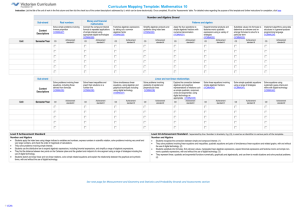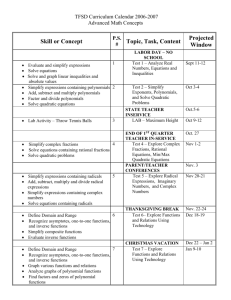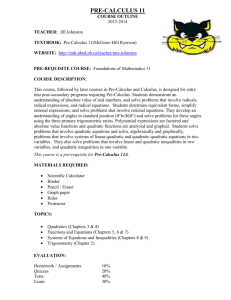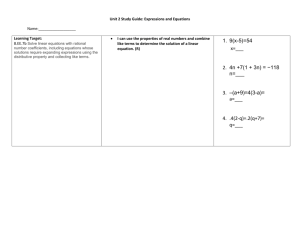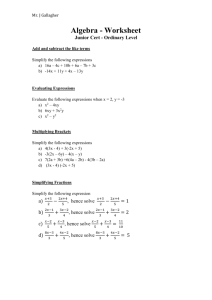Curriculum Mapping Template: Mathematics 10
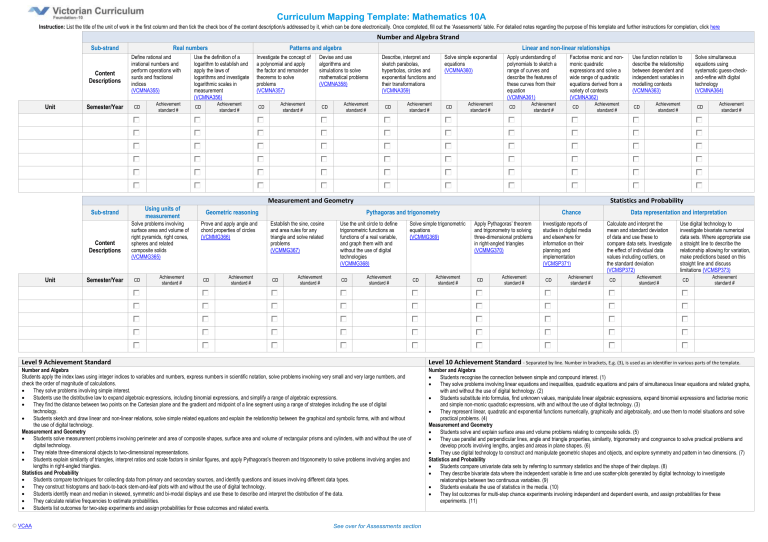
Curriculum Mapping Template: Mathematics 10A
Instruction: List the title of the unit of work in the first column and then tick the check box of the content description/s addressed by it, which can be done electronically. Once completed, fill out the ‘Assessments’ table. For detailed notes regarding the purpose of this template and further instructions for completion, click here
Number and Algebra Strand
Unit
Sub-strand
Content
Descriptions
Semester/Year
Define rational and irrational numbers and perform operations with surds and fractional indices
(VCMNA355)
CD
Real numbers
Achievement standard #
Use the definition of a logarithm to establish and apply the laws of logarithms and investigate logarithmic scales in measurement
(VCMNA356)
CD
Achievement standard #
Patterns and algebra
Investigate the concept of a polynomial and apply the factor and remainder theorems to solve problems
(VCMNA357)
Devise and use algorithms and simulations to solve mathematical problems
(VCMNA358)
CD
Achievement standard #
CD
Achievement standard #
Describe, interpret and sketch parabolas, hyperbolas, circles and exponential functions and their transformations
(VCMNA359)
CD
Achievement standard #
Solve simple exponential equations
(VCMNA360)
CD
Achievement standard #
Linear and non-linear relationships
Apply understanding of polynomials to sketch a range of curves and describe the features of these curves from their equation
(VCMNA361)
CD
Achievement standard #
Factorise monic and nonmonic quadratic expressions and solve a wide range of quadratic equations derived from a variety of contexts
(VCMNA362)
CD
Achievement standard #
Use function notation to describe the relationship between dependent and independent variables in modelling contexts
(VCMNA363)
CD
Achievement standard #
Solve simultaneous equations using systematic guess-checkand-refine with digital technology
(VCMNA364)
CD
Achievement standard #
Sub-strand Geometric reasoning
Measurement and Geometry
Pythagoras and trigonometry Chance
Statistics and Probability
Data representation and interpretation
Unit
Content
Descriptions
Using units of measurement
Solve problems involving surface area and volume of right pyramids, right cones, spheres and related composite solids
(VCMMG365)
Semester/Year
CD
Achievement standard #
Prove and apply angle and chord properties of circles
(VCMMG366)
CD
Achievement standard #
Establish the sine, cosine and area rules for any triangle and solve related problems
(VCMMG367)
CD
Achievement standard #
Use the unit circle to define trigonometric functions as functions of a real variable, and graph them with and without the use of digital technologies
(VCMMG368)
CD
Achievement standard #
Solve simple trigonometric equations
(VCMMG369)
CD
Achievement standard #
Apply Pythagoras’ theorem and trigonometry to solving three-dimensional problems in right-angled triangles
(VCMMG370)
CD
Achievement standard #
Investigate reports of studies in digital media and elsewhere for information on their planning and implementation
(VCMSP371)
CD
Achievement standard #
Calculate and interpret the mean and standard deviation of data and use these to compare data sets. Investigate the effect of individual data values including outliers, on the standard deviation
(VCMSP372)
CD
Achievement standard #
Use digital technology to investigate bivariate numerical data sets. Where appropriate use a straight line to describe the relationship allowing for variation, make predictions based on this straight line and discuss limitations (VCMSP373)
CD
Achievement standard #
Level 9 Achievement Standard
Number and Algebra
Students apply the index laws using integer indices to variables and numbers, express numbers in scientific notation, solve problems involving very small and very large numbers, and check the order of magnitude of calculations.
They solve problems involving simple interest.
Students use the distributive law to expand algebraic expressions, including binomial expressions, and simplify a range of algebraic expressions.
They find the distance between two points on the Cartesian plane and the gradient and midpoint of a line segment using a range of strategies including the use of digital technology.
Students sketch and draw linear and non-linear relations, solve simple related equations and explain the relationship between the graphical and symbolic forms, with and without the use of digital technology.
Measurement and Geometry
Students solve measurement problems involving perimeter and area of composite shapes, surface area and volume of rectangular prisms and cylinders, with and without the use of digital technology.
They relate three-dimensional objects to two-dimensional representations.
Students explain similarity of triangles, interpret ratios and scale factors in similar figures, and apply Pythagoras's theorem and trigonometry to solve problems involving angles and lengths in right-angled triangles.
Statistics and Probability
Students compare techniques for collecting data from primary and secondary sources, and identify questions and issues involving different data types.
They construct histograms and back-to-back stem-and-leaf plots with and without the use of digital technology.
Students identify mean and median in skewed, symmetric and bi-modal displays and use these to describe and interpret the distribution of the data.
They calculate relative frequencies to estimate probabilities.
Students list outcomes for two-step experiments and assign probabilities for those outcomes and related events.
Level 10 Achievement Standard
- Separated by line. Number in brackets, E.g. (3), is used as an identifier in various parts of the template.
Number and Algebra
Students recognise the connection between simple and compound interest. (1)
They solve problems involving linear equations and inequalities, quadratic equations and pairs of simultaneous linear equations and related graphs, with and without the use of digital technology. (2)
Students substitute into formulas, find unknown values, manipulate linear algebraic expressions, expand binomial expressions and factorise monic and simple non-monic quadratic expressions, with and without the use of digital technology. (3)
They represent linear, quadratic and exponential functions numerically, graphically and algebraically, and use them to model situations and solve practical problems. (4)
Measurement and Geometry
Students solve and explain surface area and volume problems relating to composite solids. (5)
They use parallel and perpendicular lines, angle and triangle properties, similarity, trigonometry and congruence to solve practical problems and develop proofs involving lengths, angles and areas in plane shapes. (6)
They use digital technology to construct and manipulate geometric shapes and objects, and explore symmetry and pattern in two dimensions. (7)
Statistics and Probability
Students compare univariate data sets by referring to summary statistics and the shape of their displays. (8)
They describe bivariate data where the independent variable is time and use scatter-plots generated by digital technology to investigate relationships between two continuous variables. (9)
Students evaluate the use of statistics in the media. (10)
They list outcomes for multi-step chance experiments involving independent and dependent events, and assign probabilities for these experiments. (11)
©
VCAA See over for Assessments section
Curriculum Mapping Template: Mathematics 10
Assessments
Unit (Title) Assessment Achievement Standard/s
Unit (Title)
Assessment Achievement Standard/s
© VCAA Page 2


